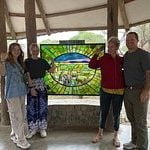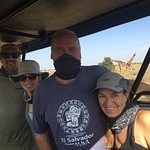Everything you need to know!
Mount Kilimanjaro (5895 meters), the highest free-standing mountain in the world and the highest mountain in Africa, is located in Tanzania. The majority of climbers only need a walking stick, appropriate clothing, and willpower to reach the summit (Uhuru Peak) of Kilimanjaro, one of the world’s highest summits, despite its height.
From the tropical rain forest on the lower slopes and the alpine heath to an almost bare alpine desert and finally the wintry Arctic summit of snow and ice, just 3 degrees south of the Equator, climbing Mount Kilimanjaro is like taking a virtual climate tour of the world.
Which route should I choose?
You need more knowledge and understanding of the differences between the routes before you can choose one. On Mount Kilimanjaro, there are seven recognized climbing routes.
| North of Mountain | South of Mountain | West of Mountain |
|---|---|---|
| Rongai | Marangu | Shira |
| Machame | Lemosho | |
| Umbwe | North Circuit |

Marangu Route
One of the most well-known routes to the top of Mount Kilimanjaro is the Marangu route, also referred to as the “Coca Cola route.” Since it can be completed in 5 days, the Marangu route is thought by many hikers to be the simplest way to reach Uhuru Peak (making it a lower budget option).
Machame Route
The most well-known and successful route to the top of Kilimanjaro is the Machame route, also referred to as the “Wiskey route.” The Machame route is regarded as a challenging route and is better suited to more experienced hikers and trekkers with previous backpacking or hiking experience. because the Marangu route is more difficult and requires longer hiking hours.


Umbwe Route
The Umbwe route is famous for its caves; the first night, you actually spend the night at the Umbwe Cave Camp, and the following day, you can visit two more caves along the way. One of the quickest routes to the Southern Glaciers and the Western Breach is the Umbwe route, which is steeper than the Machame route. It is most likely one of Kilimanjaro’s scenic and easiest routes. However, there are greater risks when attempting to reach the summit via the Western Breach/Arrow Glacier and spending the night at the Arrow Glacier camp.
Lemosho Route
The first day of the trek includes an armed ranger along the Lemosho Route, which is a very scenic and unspoiled route. Elephants, buffalo, and other animals live in the forests surrounding the Lemosho Glades. You might catch a glimpse of them while on your journey.


Rongai Route
One of the simplest routes with a very high success rate is the Rongai Route, also referred to as the “Fanta route.” It is one of the less traveled routes and begins on the north side of the mountain, south of the Kenyan border. The main benefit of this route is that climbers will be able to view the mountain from a variety of angles because they will be descending on the mountain’s south-eastern side.
The Northern Circuit
Starting your hike on the Rongai route, switch to the Machame route at the Shira plateau, attempt the summit from the Barafu camp, and return via the Mweka route instead of continuing east toward Mawenzi peak. Although the Rongai route descends along the Marangu route as well, you do not use the Marangu route’s huts and instead sleep in tents. Start out on the Lemosho route, and on day three, rather than going east towards Lava Tower, head north to connect with the Rongai route. From the Kibo hut, attempt the summit, and then descend using the Mweka route.


Shira Route
The Shira Route is a less commonly used route near Shira Ridge, similar to the Lemosho route. Shira was the original, but Lemosho is an improved version. However, Shira is less favored due to its higher starting altitude, reached quickly by vehicle. Climbers may experience altitude symptoms at the 11,800 feet camp. The route starts with a drive to Shira Ridge, bypassing the rainforest. It then crosses the Shira Plateau and the Southern Circuit before reaching the summit from Barafu. Descent is through the Mweka route.
Trek Group Departures to Join
FAQs
When is the best time to climb Kilimanjaro?
The best months to climb Kilimanjaro tend to be the warmest and driest months – January, February, and September. June, July, August and October are also good months. However, temperatures and weather are unpredictable, and can change drastically based on the time of day and altitude. For most people, it’s best to avoid the long rainy season, from the end of March to early June, and the short rainy season, from November through the beginning of December.
How much does it cost to climb Kilimanjaro?
Do not select a company strictly based on price! Price should be only one component in your overall decision. Prices vary significantly between operators, however high prices and low prices should both be viewed with caution. African Traits offers high quality climbs at reasonable rates. At our price levels, we can satisfy all park fees, pay real wages to staff, supply good food and equipment, while still providing great service to our clients, equal or better than climbs costing much more.
Which is the best route for climbing Kilimanjaro?
Each route has different characteristics that may or may not appeal to you. Consider the difficulty, scenery and crowds when you select your route. Other factors that should be considered are your age, fitness level, medical conditions, backpacking and hiking experience, experience at high altitude, degree of motivation, and any other special considerations. African Traits recommends the Northern Circuit, Lemosho, Machame and Rongai routes. Which is best depends on your specific situation.
How long does it take to climb Kilimanjaro?
The more days that you spend on the mountain, the higher your chances of reaching the summit. Statistics show that each additional day you spend acclimatizing increases your probability of success. Therefore we strongly recommend that you do not book the minimum number of days. Odds are you will experience altitude sickness, won’t enjoy your hike, and won’t reach the top. Seven or more days is highly recommended for a safe and successful climb. Our 8 and 9 day routes are the most popular.
What is the weather like on Kilimanjaro?
Mount Kilimanjaro does not experience wide temperature changes from season to season. Instead, the temperatures on Mount Kilimanjaro are determined more so by the altitude and time of day. The trek from base to summit crosses several distinct climate zones, each with different temperatures, humidity, and precipitation levels. On the lower slopes, the average temperature is around 70-80F and decreases as you gain elevation. At the top, night time temperatures can range between 20 to -20F.
What gear do I need to climb Kilimanjaro?
You are responsible for bringing personal gear and equipment while communal equipment (tents, food, cooking items, etc.) is provided. Our comprehensive gear list contains everything you need to tackle the mountain’s varied terrain and weather. It includes technical clothing such as a waterproof jacket, insulated jacket and base layers as well as equipment such as a backpack and sleeping bag. Note that you will only carry a small daypack with you while you hike between camps. The remainder of your gear is transported by our support crew. No need to carry heavy packs!
How do I train to climb Kilimanjaro?
It is very hard to gauge the mental and physical strength needed to climb Kilimanjaro. If you’ve spoken to those who have successfully or unsuccessfully climbed it, you’d get a wide range of accounts. The truth is, like any other activity, some people excel at it and some people struggle. We recommend a minimum of two months of physical training – more if you are out of shape, less if you are already an avid hiker. The best exercise is doing day hikes for four to six hours, with moderate elevation changes (~1,500 ft), while carrying a 20 lb. pack. Endurance is key, so focus on long sessions at a slow pace.







